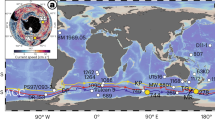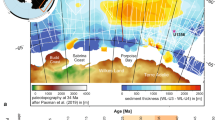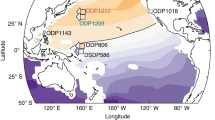Abstract
The production of cold, deep waters in the Southern Ocean is an important factor in the Earth's heat budget1. The supply of deep water to the Pacific Ocean is presently dominated by a single source, the deep western boundary current east of New Zealand. Here we use sediment records deposited under the influence of this deep western boundary current to reconstruct deep-water properties and speed changes during the Pleistocene epoch. In physical and isotope proxies we find evidence for intensified deep Pacific Ocean inflow and ventilation during the glacial periods of the past 1.2 million years. The changes in throughflow may be directly related to an increased production of Antarctic Bottom Water during glacial times. Possible causes for such an increased bottom-water production include increasing wind strengths in the Southern Ocean or an increase in annual sea-ice formation, leaving dense water after brine rejection and thereby enhancing deep convection. We infer also that the global thermohaline circulation was perturbed significantly during the mid-Pleistocene climate transition between 0.86 and 0.45 million years ago.
This is a preview of subscription content, access via your institution
Access options
Subscribe to this journal
Receive 51 print issues and online access
$199.00 per year
only $3.90 per issue
Buy this article
- Purchase on Springer Link
- Instant access to full article PDF
Prices may be subject to local taxes which are calculated during checkout



Similar content being viewed by others
References
Clarke, A., Church, J. & Gould, J. in Ocean Circulation and Climate—Observing and Modelling the Global Ocean (eds Siedler, G. et al.) 11–30 (Academic, San Diego, 2001).
Raymo, M. E., Oppo, D. W. & Curry, W. The mid-Pleistocene climate transition: A deep sea carbon isotopic perspective. Paleoceanography 12, 546–559 (1997).
McCave, I. N., Manighetti, B. & Beveridge, N. A. S. Circulation of the glacial North Atlantic inferred from grain-size measurements. Nature 374, 149–151 (1995).
Shipboard Scientific Party. Site 1123: North Chatham Drift— a 20 Ma record of the Pacific Deep Western Boundary Current. Proc. ODP Init. Rep. [CD-ROM] Leg 181, 1–184 (1999).
Warren, B. A. Transpacific hydrographic sections at lats. 43°S and 28°S: The SCORPIO Expedition—II Deep water. Deep-Sea Res. 20, 9–38 (1973).
Imbrie, J. & Imbrie, J. Z. Modeling the climatic response to orbital variations. Science 207, 943–953 (1980).
Berger, A. & Loutre, M. F. Insolation values for climate of the last 10 million years. Quat. Sci. Rev. 10, 297–317 (1991).
Bassinot, F. C. et al. The astronomical theory of climate and the age of the Bruhnes-Matuyama magnetic reversal. Earth Planet. Sci. Lett. 126, 91–108 (1994).
McCave, I. N., Manighetti, B. & Robinson, S. G. Sortable silt and fine sediment size/composition slicing: Parameters for palaeocurrent speed and palaeoceanography. Paleoceanography 10, 593–610 (1995).
Carter, L. & Wilkin, J. Abyssal circulation around New Zealand—a comparison between observations and a global circulation model. Mar. Geol. 159, 221–239 (1999).
Hall, I. R., McCave, I. N., Chapman, M. R. & Shackleton, N. J. Coherent deep flow variation in the Iceland and American basins during the last interglacial. Earth Planet. Sci. Lett. 164, 15–21 (1998).
McCave, I. N. & Carter, L. Recent sedimentation beneath the Deep Western Boundary Current off Northern New Zealand. Deep-Sea Res. 44, 1203–1237 (1997).
Marcantonio, F. et al. Sediment focusing in the central equatorial Pacific Ocean. Paleoceanography 16, 260–267 (2001).
Jansen, J. H. F., Kuijpers, A. & Troelstra, S. R. A mid-Brunhes climatic event—long-term changes in global atmosphere and ocean circulation. Science 232, 619–622 (1986).
Mackensen, A. et al. The δ13C in benthic foraminiferal tests of Fontbotia wuellerstorfi (Schwager) relative to the δ13C of dissolved inorganic carbon in Southern Ocean deep water: Implications for glacial ocean circulation models. Paleoceanography 8, 587–610 (1993).
Lean, C. M. B. & McCave, I. N. Glacial to interglacial mineral magnetic and palaeoceanographic changes at Chatham Rise, SW Pacific Ocean. Earth Planet. Sci. Lett. 163, 247–260 (1998).
Dymond, J., Suess, E. & Lyle, M. Barium in deep-sea sediment: a geochemical proxy for paleoproductivity. Paleoceanography 7, 163–182 (1992).
Mix, A. C. et al. Benthic foraminifer stable isotope record from Site 849 (0-5 Ma): Local and global climate changes. Proc. ODP Sci. Res. 138, 371–412 (1995).
Kroopnick, P. M. The distribution of 13C of ΣCO2 in the world oceans. Deep-Sea Res. 32, 57–84 (1985).
Kroopnick, P. M. The dissolved O2-CO2-13C system in the eastern equatorial Pacific. Deep-Sea Res. 21, 211–227 (1974).
Charles, C. D. & Fairbanks, R. G. Evidence from Southern Ocean sediments for the effect of North Atlantic deep-water flux on climate. Nature 355, 416–419 (1992).
Yu, E.-F., Francois, R. & Bacon, M. P. Similar rates of modern and last-glacial ocean thermohaline circulation inferred from radiochemical data. Nature 379, 689–694 (1996).
Adkins, J. F. & Boyle, E. A. Changing atmospheric Δ14C and the record of deep water paleoventilation ages. Paleoceanography 12, 337–344 (1997).
Sikes, E. L. et al. Old radiocarbon ages in the southwest Pacific Ocean during the last glacial period and deglaciation. Nature 405, 555–559 (2000).
Bard, E. et al. The North-Atlantic atmosphere-sea surface 14C gradient during the Younger Dryas climatic event. Earth Planet. Sci. Lett. 126, 275–287 (1994).
Toggweiler, J. R. & Samuels, B. in The Global Carbon Cycle (ed. Heimann, H.) 333–366 (Springer, Berlin, 1993).
Rahmstorf, S. & England, M. H. Influence of southern hemisphere winds on North Atlantic Deep Water flow. J. Phys. Oceanogr. 27, 2040–2054 (1997).
Carter, L., Carter, R. M., McCave, I. N. & Gamble, J. Regional sediment recycling in the abyssal S.W. Pacific Ocean. Geology 24, 735–738 (1996).
Bianchi, G. G., Hall, I. R., McCave, I. N. & Joseph, L. Measurement of the sortable silt current speed proxy using the Sedigraph 5100 and Coulter Multisizer IIe: precision and accuracy. Sedimentology 46, 1001–1014 (1999).
Pardo-Igúzquiza, E., Chica-Olmo, M. & Rodriguez-Tovar, J. CYSTRATI: a computer program for spectral analysis of stratigraphic successions. Comput. Geosci. 20, 511–584 (1994).
Mann, M. E. & Lees, J. Robust estimation of background noise and signal detection in climatic time series. Clim. Change 33, 409–445 (1996).
Bloomfield, P. Fourier Analysis of Time Series: an Introduction (Wiley, London, 1976).
Acknowledgements
We thank A. Fulop, M. Hall, L. Tiegang, P. Knutz and N. Walsh for experimental assistance, and the captain, crew and shipboard scientific party of Leg 181 for their help. Samples were provided by the Ocean Drilling Program (ODP), with the support of the Natural Environment Research Council and the UK ODP.
Author information
Authors and Affiliations
Corresponding author
Supplementary information
Rights and permissions
About this article
Cite this article
Hall, I., McCave, I., Shackleton, N. et al. Intensified deep Pacific inflow and ventilation in Pleistocene glacial times. Nature 412, 809–812 (2001). https://doi.org/10.1038/35090552
Received:
Accepted:
Issue Date:
DOI: https://doi.org/10.1038/35090552
This article is cited by
-
Orbital- and millennial-scale Antarctic Circumpolar Current variability in Drake Passage over the past 140,000 years
Nature Communications (2021)
-
Deglacial patterns of South Pacific overturning inferred from 231Pa and 230Th
Scientific Reports (2021)
-
Response of a comprehensive climate model to a broad range of external forcings: relevance for deep ocean ventilation and the development of late Cenozoic ice ages
Climate Dynamics (2019)
-
Neodymium isotope evidence for glacial-interglacial variability of deepwater transit time in the Pacific Ocean
Nature Communications (2018)
-
Closure of the Bering Strait caused Mid-Pleistocene Transition cooling
Nature Communications (2018)
Comments
By submitting a comment you agree to abide by our Terms and Community Guidelines. If you find something abusive or that does not comply with our terms or guidelines please flag it as inappropriate.



